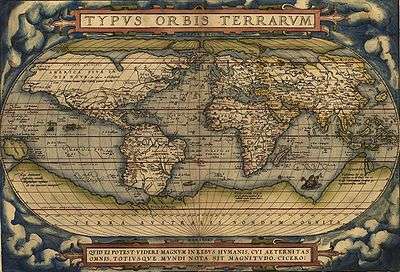Pieter Dirkszoon Keyser
Pieter Dirkszoon Keyser (occasionally Petrus Theodorus; c. 1540 – 11 September 1596) was a Dutch navigator and celestial cartographer who mapped several constellations on the southern celestial hemisphere.
Pieter Dirkszoon Keyser | |
|---|---|
| Born | Unknown date, c. 1540 |
| Died | 11 September 1596 (aged 55–56) Sunda Strait, East Indies |
| Other names | Petrus Theodorus |
| Occupation | Celestial cartographer, navigator |
| Known for | Charting of constellations on the southern celestial hemisphere |
Voyages and star observation
Little is known of Keyser's life outside of his astronomical observations and East Indies voyages.[1] After several trips, one to Brazil, and one to Nova Zembla,[2] Keyser participated as the chief navigator and head of the steersmen for the first Dutch voyage to the East Indies (the "Eerste Schipvaart"), which left Texel with four ships on 2 April 1595 under Cornelis de Houtman. He had been trained by cartographer Petrus Plancius in mathematics and astronomy. Plancius, a key promoter to the Dutch East Indies expeditions, had instructed Keyser to map the skies in the southern hemisphere, which were largely uncharted at the time.[1][3] When the fleet finally was able to obtain fresh supplies at Madagascar on 13 September, 71 of the 248 sailors had died, most of scurvy. The surviving crew stayed for several months on the island, to recover and make repairs, at which point Keyser probably made most of his celestial observations. He was aided in this by Frederick de Houtman and Vechter Willemsz. After leaving Madagascar, it took another four months (February to June 1596) for the ships to reach Sumatra and finally Bantam on Java. Trade negotiations went sour, perhaps caused by Portuguese instigators, perhaps by inexperience, and the crew was forced to find drinking water and other supplies on Sumatra across the Sunda Strait. Keyser apparently died during this crossing. On 14 August 1597, 81 survivors made it back to Texel, including de Houtman, who probably delivered Keyser's observations to Plancius.
Constellations
From the observations of the expedition, Plancius created a celestial globe in late 1597, published by Jodocus Hondius, showing twelve new constellations of the southern sky that have become accepted among the standard constellations codified by modern astronomers. The majority were named after various animals that 16th century explorers had encountered (e.g. Bird of Paradise, Chameleon, Toucan, Flying Fish). Willem Janszoon Blaeu copied these constellations on a 1602 globe and created a new globe in 1603 incorporating further observations made by de Houtman on a second voyage to the East Indies. Johann Bayer included these new southern constellations in his influential 1603 star atlas Uranometria, crediting them to "Petrus Theodori" (Pieter Keyser),[4] but not acknowledging their earlier publication. Bayer is therefore often mistakenly credited for introducing them.[5]
Keyser is commemorated by minor planet (10655) Pietkeyser.[6]
See also
- Dutch celestial cartography in the Age of Exploration (Early systematic mapping of the far southern sky, c. 1595–1599)
- Constellations created and listed by Dutch celestial cartographers
- Petrus Plancius
- First Dutch Expedition to Indonesia
- Second Dutch Expedition to Indonesia
- Dutch East India Company in Indonesia
- European exploration of Australia
- Janszoon voyage of 1605–06
- Voyage of the Pera and Arnhem to Australia in 1623
- New Holland (Australia)
- Australian places with Dutch names
- History of the Northern Territory
- History of Western Australia
- History of South Australia
- History of Tasmania
References
Footnotes
- Knobel, E. B. (March 1917). "On Frederick de Houtman's catalogue of southern stars, and the origin of the southern constellations". Monthly Notices of the Royal Astronomical Society. 77: 414–432. Bibcode:1917MNRAS..77..414K. doi:10.1093/mnras/77.5.414. Retrieved 12 July 2012.
- De Waard 1912, p. 674.
- Ridpath, Ian (1988). Star Tales. Cambridge: Lutterworth. p. 9. ISBN 978-0718826956.
- Kanas, Nick (2009). Star Maps: History, Artistry, and Cartography (2nd ed.). Springer. p. 119. ISBN 978-1-4614-0916-8.
- Ridpath, Ian. "Johann Bayer's Southern Star Chart". Retrieved 7 April 2015.
- "10655 Pietkeyser (9535 P-L)". Solar System Dynamics. Jet Propulsion Laboratory, California Institute of Technology. Retrieved 12 July 2012.
Bibliography
- Van der Aa, A. J. (1862). "Keizer (Pieter Dirkszoon)". Biographisch Woordenboek der Nederlanden (in Dutch). 10. Haarlem: Brederode. p. 90.CS1 maint: ref=harv (link)
- De Waard, C. (1912). "Keyser (Pieter Dircksz.)". Nieuw Nederlandsch Biografisch Woordenboek (in Dutch). 2. Leiden: Sijthoff. p. 674.CS1 maint: ref=harv (link)
